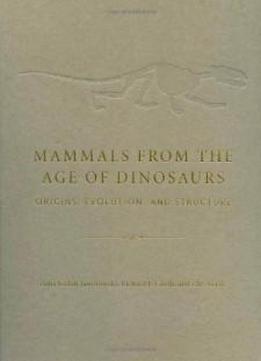
Mammals From The Age Of Dinosaurs: Origins, Evolution, And Structure
by Zofia Kielan-Jaworowska /
2004 / English / DjVu
13.3 MB Download
The fossil record on Mesozoic mammals has expanded by orders of
magnitude over the past quarter century. New specimens, some of
them breathtakingly complete, have been found in nearly all parts
of the globe at a rapid pace. Coupled with the application of new
scientific approaches and techniques, these exciting discoveries
have led to profound changes in our interpretation of early
mammal history.
The fossil record on Mesozoic mammals has expanded by orders of
magnitude over the past quarter century. New specimens, some of
them breathtakingly complete, have been found in nearly all parts
of the globe at a rapid pace. Coupled with the application of new
scientific approaches and techniques, these exciting discoveries
have led to profound changes in our interpretation of early
mammal history.
Mesozoic mammals have come into their own as a rich source of
information for evolutionary biology. Their record of episodic,
successive radiations speaks to the pace and mode of evolution.
Early mammals were small, but they provide key information on the
morphological transformations that led to modern mammals,
including our own lineage of Placentalia. Significant and
fast-evolving elements of the terrestrial biota for much of the
Mesozoic, early mammals have played an increasingly important
role in studies of paleoecology, faunal turnover, and historical
biogeography. The record of early mammals occupies center stage
for testing molecular evolutionary hypotheses on the timing and
sequence of mammalian radiations.
Mesozoic mammals have come into their own as a rich source of
information for evolutionary biology. Their record of episodic,
successive radiations speaks to the pace and mode of evolution.
Early mammals were small, but they provide key information on the
morphological transformations that led to modern mammals,
including our own lineage of Placentalia. Significant and
fast-evolving elements of the terrestrial biota for much of the
Mesozoic, early mammals have played an increasingly important
role in studies of paleoecology, faunal turnover, and historical
biogeography. The record of early mammals occupies center stage
for testing molecular evolutionary hypotheses on the timing and
sequence of mammalian radiations.
Organized according to phylogeny, this book covers all aspects of
the anatomy, paleobiology, and systematics of all early mammalian
groups, in addition to the extant mammalian lineages extending
back into the Mesozoic.
Organized according to phylogeny, this book covers all aspects of
the anatomy, paleobiology, and systematics of all early mammalian
groups, in addition to the extant mammalian lineages extending
back into the Mesozoic.











